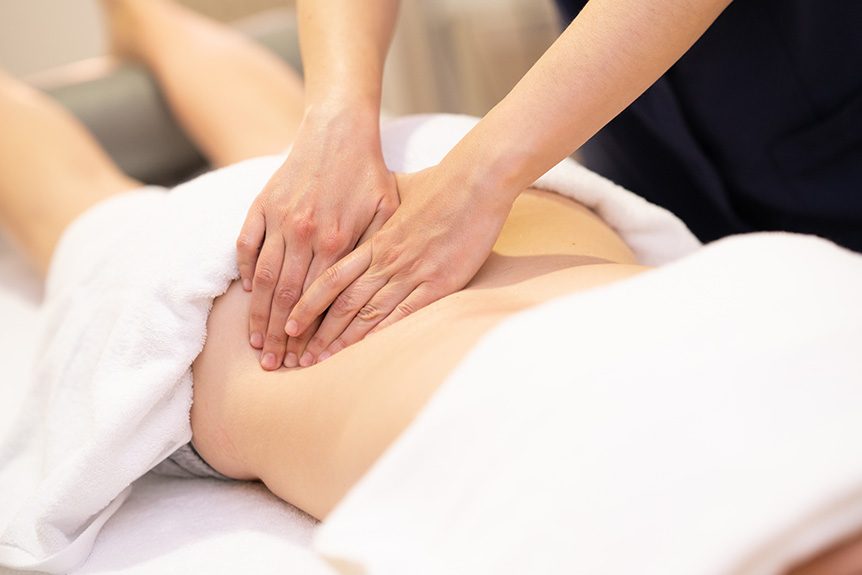Yes. This massage can ease sciatic-related pain by reducing myofascial hypertonicity and trigger points in the piriformis, deep gluteals, and lumbar paraspinals, improving neural and fascial glide and modulating nociception. Therapists use slow, graded pressure, myofascial release, and neural sliders when appropriate. It is avoided with red flags (worsening weakness, fever, recent trauma, infection, DVT risk). Expect transient soreness. Gentle walking and nerve sliders support results. The following sections explain techniques, suitability, and safety.
Understanding Sciatica and Why It Hurts

Sciatica refers to pain originating from irritation or compression of the lumbosacral nerve roots (most commonly L4–S1) or the proximal sciatic nerve, producing symptoms that radiate from the lower back or buttock down the posterior or lateral thigh and, at times, below the knee to the foot.
Typical drivers include lumbar disc herniation, foraminal stenosis, spondylolisthesis, or piriformis-related entrapment. Inflammation around the nerve sensitises nociceptors, amplifying mechanical and thermal pain signals.
Patients often report electric, burning lines of discomfort, focal numbness, or weakness along dermatomal patterns, with cough or prolonged sitting worsening symptoms.
From Spa & Massage’s clinical perspective, understanding load, posture, and daily movement patterns matters. Therapists listen for aggravating positions, map tenderness, and respect neural tissue irritability—pairing precise touch with calm pacing and breath awareness.
Many individuals find that approaches such as aromatherapy massage can help address both physical discomfort and promote deep relaxation, further supporting pain management in sciatica.
How Deep Tissue Massage Targets Sciatic-Related Pain
Precisely applied this massage technique modulates nociception and mechanical load along the lumbosacral–gluteal–posterior thigh continuum by addressing myofascial hypertonicity and trigger points that sensitize or compress neural structures.
At Spa & Massage, therapists prioritise the piriformis, deep external rotators, gluteus medius/minimus, and proximal hamstrings—regions where taut bands can irritate the sciatic nerve. Slow, sustained pressure and friction are used to lengthen shortened fascia, reduce trigger point irritability, and improve intramuscular perfusion, which collectively downregulates peripheral and central sensitisation.
Clinicians apply graded force perpendicular and parallel to fibre direction, integrating sciatic nerve–sparing angles and client-guided breathing to ease guarding.
Joint-positioning places tissues on gentle tension while respecting neural mobility. As tone normalises, load sharing through the pelvis improves, stride becomes smoother, and radiating symptoms often retreat from calf to buttock—an intimate relief earned through precise care.
When Deep Muscle Therapy Is Appropriate for Sciatica
Deep muscle therapy is most appropriate when sciatica symptoms are driven by myofascial dysfunction—such as piriformis syndrome, gluteal trigger points, or lumbar paraspinal hypertonicity—rather than by acute nerve root compression.
At Spa & Massage, therapists assess red flags and symptom patterns to identify muscle-mediated pain that may respond to graded pressure, neuromuscular techniques, and tissue lengthening.
Massage should be avoided with red flags such as progressive neurological deficit, recent trauma, suspected cauda equina, active infection, fever, or unexplained weight loss, and also deferred during acute inflammation or severe pain exacerbations pending medical evaluation.
Muscle-Related Sciatic Pain
In many cases, radiating leg pain attributed to the sciatic nerve stems from myofascial dysfunction rather than disc pathology—most commonly piriformis syndrome, gluteal trigger points, hamstring tension at the ischial tuberosity, and lumbar paraspinal hypertonicity compressing or irritating the lumbosacral plexus.
In these presentations, deep tissue techniques can modulate nociception, reduce taut band activity, and restore glide along neural and fascial planes. At Spa & Massage, therapists apply slow, graded pressure to the piriformis and deep gluteals, longitudinal stripping to proximal hamstrings, and sustained compressions to lumbar erectors, always respecting tissue tolerance and breath.
Sessions often integrate gentle nerve-mobility positions and targeted hip external rotator stretching. Clients are guided to maintain hydration, use heat judiciously, and perform brief daily mobility to consolidate relief.
When to Avoid Massage
When should deep muscle therapy be deferred in suspected sciatica?
It should be avoided with red-flag features: new bowel or bladder dysfunction, saddle anaesthesia, progressive motor weakness (foot drop), severe unremitting night pain, fever, unexplained weight loss, or history of malignancy—signs requiring urgent medical assessment.
Massage is also contraindicated over acute thrombosis, active infection, open wounds, or recent trauma.
In acute disc herniation with sharp, radiating pain and neurological deficits, vigorous pressure along the lumbar paraspinals, piriformis, and sciatic nerve path may exacerbate inflammation.
Spa & Massage therapists screen for these risks and modify care accordingly.
During pregnancy with new radicular pain, referral is prudent.
If symptoms stem from vertebral fracture, inflammatory spondyloarthropathy, or systemic illness, they defer treatment and guide clients to appropriate clinicians before resuming gentle, staged therapy.
Techniques Our Therapists Use for Sciatica Relief

How do targeted manual therapies modulate sciatic nerve irritation and lumbopelvic dysfunction? At Spa & Massage, therapists prioritise techniques that down‑regulate nociception, ease neural mechanosensitivity, and restore tissue glide.
They apply slow, graded pressure to paraspinals and deep hip rotators—especially piriformis and obturator internus—to reduce myofascial trigger points compressing the sciatic pathway. Longitudinal stripping along quadratus lumborum and gluteus medius minimises guarding that destabilises pelvic alignment.
They integrate myofascial release to improve fascial extensibility across the thoracolumbar fascia and iliotibial tract, then utilise contract–relax stretching to optimise hip external rotation range. Neural mobilisation—gentle slump and straight‑leg nerve glides—is introduced when appropriate to enhance axoplasmic flow without provocation.
Finally, targeted cross‑fiber friction at tendon insertions promotes local circulation and supports load tolerance, always titrated to client feedback.
What to Expect During a Session at Spa & Massage
A typical sciatica-focused session at Spa & Massage begins with a brief clinical intake to clarify symptom behaviour, red flags, and aggravating movements, followed by a focused lumbar–pelvic–hip assessment (active range, resisted isometrics, neural tension screens).
With consent, the therapist explains an evidence-based plan: graded pressure to paraspinals, gluteus medius/maximus, deep lateral rotators, piriformis, and hamstring proximal attachments; slow stripping along erector spinae and quadratus lumborum; myofascial release to thoracolumbar fascia; and cautious mobilization near the sacroiliac region.
Clients are positioned for comfort, often side-lying to reduce neural tension.
In our clinics, unscented hypoallergenic oil supports controlled glide.
Communication is quiet, attuned, and precise—pressure is titrated, breath is coached.
Sessions finish with gentle nerve-friendly mobility cues and personalised spacing of follow-ups.
Benefits and Potential Risks to Be Aware Of
Though outcomes vary by presentation, deep muscle therapy for sciatica can reduce nociceptive input from lumbar paraspinals, quadratus lumborum, gluteal musculature, deep lateral rotators (including piriformis), and proximal hamstrings. This can improve tissue extensibility, segmental mobility, and perceived pain intensity while facilitating more efficient lumbopelvic motor control.
Evidence suggests short-term reductions in pain and disability when myofascial density and trigger points are addressed, especially when combined with graded movement.
Potential risks are uncommon but include transient soreness, post-treatment fatigue, temporary bruising, symptom flare if pressure is excessive, or neural irritability when the sciatic nerve is compressed.
Red flags—progressive weakness, saddle anaesthesia, fever, unexplained weight loss—warrant medical assessment, not massage.
At Spa & Massage, therapists modulate depth, avoid neurally sensitive windows, obtain informed consent, and adapt positioning for comfort and safety.
At-Home Aftercare and Stretches We Recommend
Spa & Massage advises immediate self-care after treatment: hydrate, apply intermittent cold or gentle heat to the lumbar–gluteal region, and avoid heavy loading for 24 hours to reduce neuroinflammatory irritability.
Their therapists recommend gentle daily mobility focused on the lumbopelvic complex, including supine sciatic nerve glides and posterior chain lengthening within pain-free range.
Consistency with these measures supports tissue recovery, reduces nociceptive input, and helps maintain gains from deep tissue work.
Immediate Self-Care Steps
Following a deep tissue session for sciatic pain, immediate self-care focuses on calming neural irritation, reducing nociceptive input from the lumbar spine, gluteals, and posterior hip, and preserving tissue length gains.
Spa & Massage advises clients to walk gently for 3–5 minutes every hour to promote lumbar disc nutrition and venous return.
Apply intermittent cold (10 minutes, wrapped pack) to the lateral gluteal region or low back if irritable; use mild heat only if stiffness predominates, never both simultaneously.
Hydrate to support fascial recovery.
Avoid end-range lumbar flexion, heavy lifting, and prolonged sitting; keep hips higher than knees when seated.
Their therapists recommend diaphragmatic breathing: 4-second inhale, 6–8-second exhale for five cycles, relaxing the pelvic floor and gluteals, downregulating protective spasm without provoking neural tension.
Gentle Daily Stretches
A gentle daily mobility routine can reduce sciatic irritability by modulating nociception, improving neural excursion, and maintaining hip–lumbar tissue length gained in clinic.
Spa & Massage recommends brief, precise sequences: supine sciatic nerve sliders (ankle dorsiflexion with knee extension, then plantarflexion with flexion), 10 smooth reps per side; figure‑4 hip external rotation stretch, 30–45 seconds; prone press‑ups for lumbar extension tolerance, 8–10 reps; and hip flexor half‑kneel stretch to counter anterior chain stiffness, 30 seconds each side.
Movements should remain sub‑pain, with nasal breathing and relaxed jaw to down‑regulate tone.
Morning and evening practice works well after deep tissue treatment.
Therapists at Spa & Massage cue neutral pelvis, gentle abdominal engagement, and gradual range progression, aligning home care with in‑clinic outcomes.
When to Seek Medical Assessment Before Massage
Before scheduling deep tissue work for sciatica, certain red flags warrant medical assessment to exclude serious pathology. Immediate evaluation is advised for new or progressive lower-limb weakness, foot drop, saddle anesthesia, bladder or bowel dysfunction, fever, unexplained weight loss, history of cancer, significant trauma, or persistent night pain.
Sudden severe pain after lifting with neurological deficits may indicate disc herniation requiring imaging.
Deep, constant calf pain with swelling warrants DVT exclusion.
Infections, anticoagulant therapy, and uncontrolled diabetes also merit medical review.
At Spa & Massage, therapists screen for these signs during intake and will pause treatment if concerns arise.
When cleared, focused work on the gluteal complex, piriformis, and lumbar paraspinals is delivered thoughtfully, aligning touch with safety so relief unfolds without risk.
Conclusion
In closing, readers receive realistic reassurance: deep muscle therapy can soften stubborn spasms, settle sensitized tissues, and support safer stride. By addressing myofascial tightness in gluteals, piriformis, lumbar extensors, and hip rotators, therapists may reduce referred radicular-like discomfort and restore smoother segmental motion. Though not a cure for nerve compression, structured sessions, sensible screening, and staged self-care—stretching, strengthening, and posture strategies—can sustain gains. Seek medical assessment for red flags; otherwise, measured, methodical massage can meaningfully moderate sciatica-related symptoms.



